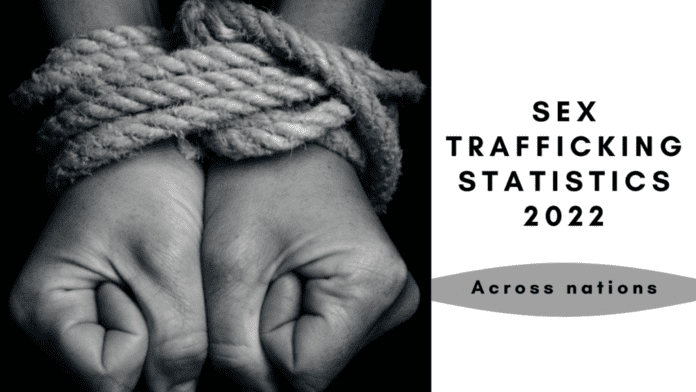News provided by Bedbible.com on Tuesday 8th Feb 2022
We spend 2 months doing an in-depth report about worldwide sex trafficking. We’ve gathered data from 172 countries, and analyzed 109.216 identified victims. This is by far the largest study and most comprehensive on the topic.
Key conclusions
- 35 million is every single day victims of sex trafficking
Estimates show that, internationally, only about .04% of survivors of trafficking cases are identified, meaning that the majority of cases go undetected. - The “industry” has never been larger – It has an estimated 99 billion $ market value
To put it into perspective the sex trafficking industry is larger than the global cocaine market and almost as big as the global PC market. Also if you aggregated the yearly revenue of McDonald’s, Netflix, Wall Disney, and Best Buy we have the same value. - During the pandemic, online recruitment increased 22%
The analysis found significant growth in the proportion of potential victims for whom Facebook (120% increase) and Instagram (95% increase) were the sites for recruitment. - There have never been so many child victims
Worldwide, almost 20% of all victims are children. However, in some parts of Africa and the Mekong region, children are the majority (up to 100%). - Why people end up in sex trafficking; Recent migration, Mental Health issues, Unstable housing, Homeless Youth, and Drug abuse
Everyone ending up in a trafficking situation has a clear and identifiable vulnerability that a trafficker preyed upon.
Data and methodology
- Data/information was collected from 172 countries with 109.216 identified victims.
- From the year 2003 – 2021.
- Estimating the full overview of trafficking is challenging since victims so often go undetected, something the United Nations refers to as “the hidden figure of crime”.
- To support the findings of this report, external sources have been used as a peer review tool.
- Sex trafficking is defined as “the range of activities involved when a trafficker uses force, fraud, or coercion to compel another person to engage in a commercial sex act”.
- It has been easier to gather data on certain regions/countries than others (which therefore can result in a minor distortion of the real picture).
Why is this report useful?
Human trafficking is divided into forced labor and sex trafficking. We’ve chosen to primarily focus on sex trafficking since this stands for 79% of all human trafficking cases in the world. This detailed-oriented approach makes room for insights that maps sex trafficking in an angle never seen before.
Lean back and prepare for news that is happening right now while you’re reading this report.
The results of the analysis
This section highlights the findings of the analysis.
Global overview

There are conservatively 35 million that daily are victims of sex trafficking. The above heatmap illustrates where in the world we’re observing the most activity.
The orange circles us, that a significant part of the victims of sex trafficking come from East Europe (Ukraine, Belarus, Moldovia, and Romania), Asia (Burma, Thailand, Cambodia, Vietnam, and the Philippines), West Africa (Nigeria, Cameroon, Ivory Coast, and Sierra Leona), and Middle America (Mexico, Colombia, Honduras, Guatemala, and Jamaica).
The green circles are where sexual exploitation is taking place. Here are countries in North- and West Europe together with USA and Asia leading areas. Especially countries like Poland, Turkey, the Philippines, Thailand, Cambodia, The Emirates, the USA, and Argentina.
Regional overview
If we dig deeper into the data we can see some interesting results in the regional areas.
Northern America
USA, Canada, and Greenland
52.36% of the world sex trafficking victims are happening in Northern America, and 84% of the sexual exploitation is females, 15% males, and 1% transgender. Looking further into the age and allocation between adults and children we’ve found the following:

Central America
Mexico, Guatemala, Honduras, Nicaragua, Costa Rica, Panama, Cuba, and the Caribbean islands
Less than 0.5% of the total number of sex trafficking cases happens here. 65% female and 35% males are the victim-distribution.

South America
Argentine, Brazil, Uruguay, Paraguay, Bolivia, Peru, Ecuador, Colombia, Venezuela, Guyana, and Surinam.
0.92% of the total amount of victims comes from South America, and looking at the sex distribution we can see that; 72% of the victims are females, 28% males, and 0% transgender. The age- and majority allocation can be seen here:

Northern Europe
Norway, Denmark, Sweden, Finland, Great Britain, Iceland, Estonia, Latvia, and Lithuania.
0.81% of the victims happen in this region. But compared to other regions the gender ratio is a bit different. 58% are females, 41% are males, and 1% are transgender. Breaking it further down on age and majority, the data shows the following:

Western Europe
France, Germany, Belgium, Austria, Switzerland, Netherland, Luxembourg, and Monaco.
Kind of the same story for Western Europe as the Northern part. 1.09% of the total number of sex trafficking is going on in countries such as France, Spain, and Portugal. 78% of victims are females and only 22% males. The pictures are also intact as regards the age- and majority distribution:

Eastern Europe
Russia, Poland, Ukraine, Romania, Bulgaria, Belarus, Hungary, Czech Republic, and Slovakia.
Eastern Europe stands for 14.07% of the victims, and the gender distribution is a bit more aligned like we saw in Northern Europe. 53% of the victims are females, 47% in males, and 0% as transgender.
Looking into the age distribution we can see that especially the 30-38-year-olds have a mentionable part of the victims in this area:

Southern Europe
Portugal, Spain, Italy, Croatia, Serbia, Greece, Albania, Macedonia, Kosovo, and Montenegro.
Compared to the other European regions. The Southern has more cases of identified sex trafficking victims. Even though it’s a minor part compared to Northern America, it’s still x3 more than the other European regions. We see that 3.13% of the sex trafficking is happening here. And this region is also dominated by female victims (88%), and a minor amount of male victims (12%).
There are not many child cases. It represents 11% of the crime and the rest is adult victims (89%).

Northern Africa
Marocco, Algeria, Tunesia, Western Sahara, Libya, Egypt, and Sudan.
Here is 2.68% of the sex trafficking occurring. 57% are females, 43% are males, and 0% are transgender. Like most regions the majority is adult victims:

Central Africa
Cameroon, Central African Republic, Chad, Congo Republic – Brazzaville, Democratic Republic of Congo, Equatorial Guinea, Gabon, and São Tomé & Principe
We don’t have that much data from this area. So it’s only 0.5% of the total amount of victims that we’ve been able to capture from this area. 67% are females and 33% are males. More interesting is that out of all cases child sex trafficking happens for 47%. That’s a really big portion and the biggest in all regions of the world.

Western Africa
Benin, Burkina Faso, Cape Verde, Côte D’Ivoire, Gambia, Ghana, Guinea, Guinea-Bissau, Liberia, Mali, Mauritania, Niger, Nigeria, Senegal, Sierra Leone, and Togo
In Western Africa is 2.81 percent identified as victims out of the total amount for the whole world. It has 63% females and 37% males, and like Middle Africa, it has relatively many child victims compared to the rest of the world.

Eastern Africa
Burundi, Comoros, Djibouti, Eritrea, Ethiopia, Kenya, Madagascar, Malawi, Mauritius, Réunion, Rwanda, Seychelles, Somalia, Somaliland, Tanzania, and Uganda
Eastern Africa has 1.45% victims out of 100%, and it is distributed with 65% females and 35% males. Looking further into the age we find that the 9-17 years old are the age group with most identified victims. This region do also has a high amount of child sex trafficking cases.

Southern Africa
Angola, Botswana, Lesotho, Mozambique, Namibia, South Africa, Swaziland, Zambia, and Zimbabwe
This region stands for less than 0.5% of the total victims in the world. There are registered 61% female cases, and 39% male cases. As regards the age breakdown and majority distribution it’s quite similar to Northern Africa.

Western Asia
Bahrain, Iraq, Jordan, Kuwait, Lebanon, Oman, State of Palestine, Qatar, Saudi Arabia, Syrian Arab Republic, United Arab Emirates, and Yemen
5.98% of the total sex trafficking is going on in Western Asia, and here are the females especially vulnerable (90%) compared to males (10%). Its the region with the fewest child trafficking cases (3%).

Central Asia
Kazakhstan, Kyrgyz Republic, Tajikistan, Turkmenistan, and Uzbekistan
2.62% of the trafficking cases come from Central Asia, and it has like the European regions almost an equal-weighted distribution between female and male cases (51% to 49%).

Southern Asia
Bangladesh, Bhutan, India, Pakistan, Nepal, Sri Lanka, and Afghanistan
1.02% of the sex trafficking victims happen in this region. 58% are females and 42% are males. More interesting is that almost 41% of the victims are between 9-17 years old.

Eastern Asia
China, Hong Kong, Japan, Macau, Mongolia, North Korea, South Korea, and Taiwan
1.29% of the identified victims occur in Eastern Asia. 86% are females and 14% are males. Compared to Southern Asia there are not many child victims.

Southern-Eastern Asia
Brunei, Burma (Myanmar), Cambodia, Timor-Leste, Indonesia, Laos, Malaysia, Philippines, Singapore, Thailand, and Vietnam
7.97 % of the total amount of victims is happening in Souther-Eastern Asia. That’s a pretty big portion compared to how many people living there. Of the many victims, 54% are females and 46% are males.

Australia and New Zealand
Australia and New Zealand
Australia and New Zealand are recognized for their less than 0.5% victims and the fact that it’s the only region with more male victims (91%) than female victims (9%). And lastly, it has only adult cases.

Sub-conclusion to global- and regional overview
The above global- and regional overview gives some interesting insights:
- Africa and Southern Asia has many child sex trafficking cases (Around 50% of all cases is with childs)
- Over 50% of the worlds sex trafficking happens in the US
- Females are more frequently a victim in sex trafficking than men. We do see that it dependts a bit on the region. E.g. European countries is close to 50/50, and in Australia and New Zealand males are more exposed.
- The age distribution shows that 30-38 year olds are most likely a victim of sex trafficking all around the world.
Sex trafficking USA; the country where it happens
Since the USA is the area where most of the sex trafficking cases are taking place, we’ve together Neal Davis Law Firm looked into how the distribution is between the states. And as you can see Texas and California is having really many cases.

The development of the industry
There is no doubt that the industry is expanding and developing with the world. We see that in different ways e.g. that online recruitment is an increasing method during the pandemic (much more about this later on).
Sexual exploitation has an estimated market value of 99 billion dollars. Which means that it’s bigger than the global cocaine market. Also, it’s almost as big as the total global PC market. In other words, we have an industry that is really big. And it does not seem like it’ll stagnate in the coming years.

So why is sex trafficking practiced, when people know it’s illegal?
Sex traffic is primarily a money game. A lot of the victims do not enter this industry by their own choice. Its often because they are in a vulnerable time in their life where they meet people that take advantage of that situation. Sadly, data shows, that they are highly underpaid compared to the service they charge. Further, a lot of them are from poor environments where the masterminds pay families around 800$ to 2000$ for a daughter. Which is juxtaposed to a whole year’s income for many families in those areas.
Sex trafficking is an profitable business (Exclusive insights)
The average annual profit for every woman in sex trafficking is 100.000$. The average for both genders is 21.800$. Further, the report reveals that sexual exploitation can yield a return on investment ranging from 100% to 1,000%. In the Netherlands, investigators were able to calculate the profit generated by two sex traffickers from a number of victims. One trafficker earned $18,148 per month from four victims (for a total of $127,036) while the second trafficker earned $295,786 in the 14 months that three women were sexually exploited.
Worldwide: Identified victims vs. estimated victims
There is a huge difference between the estimated number of victims and the actually identified victims. The identified victims are the cases that go to the police and often in court. But we know from research that the majority do not end there. It’s under 5% that is prosecuted.
That being said the identified victims statistics give a good idea about the development. So as you can see the cases are increasing significantly, and so are the earnings. Since 2014 we’ve seen a 60% increase in identified victims.

Help keep news FREE for our readers
Supporting your local community newspaper/online news outlet is crucial now more than ever. If you believe in independent journalism, then consider making a valuable contribution by making a one-time or monthly donation. We operate in rural areas where providing unbiased news can be challenging. Read More About Supporting The West Wales Chronicle


























